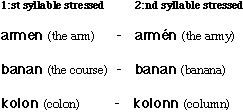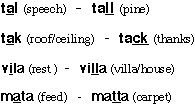prominent than surrounding syllables.
Loudness is measured in deciBels (dB), but
there is no guarantee that a stressed
syllable is stronger in dB. The perceived
strength/stress can be due to a
combination of duration and tonal
change.
Examples showing the distinctive function
of stress in Swedish:

clause, you can give it a different meaning
or a different aspect.
used. They deal with how much time is
required to pronounce a segment or a se-
quence of segments. The length of speech
sounds is practically always measured in
milliseconds.
Quantity is the term used when a
language has distinctive length.
Length in Swedish is complementary,
with a stressed syllable always containing
a long speech sound, that is a long vowel
is followed by a short consonant, and a
short vowel is followed by a long
consonant (V:C / VC:)
Examples showing the distinctive function
of length in Swedish:

accent. This refers to the fundamental
frequency of the voice. (The voice has a
fundamental frequency and a great
number of harmonics). Frequency is
measured in Hertz (Hz), which means
vibrations (cycles) per second.
The distinctive Swedish tonal accent types
are called accent 1 or acute, and accent 2 or
grave (also called bisyllabic accent).
Swedish intonation does not refer to high
or low tones, but rather rising or falling
pitch.
Examples showing the distinctive function
of tone in Swedish:

distinctive length are identical within
each word pair.